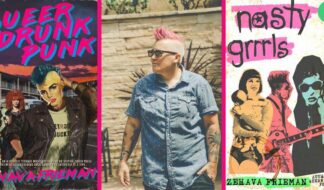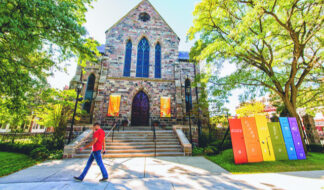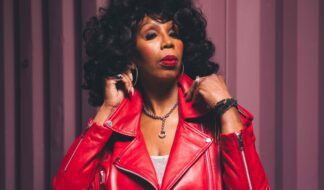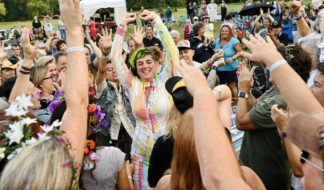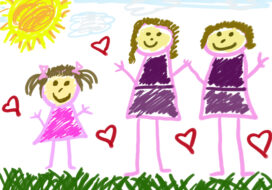by Richard Labonte
"Pacific Agony," by Bruce Benderson. Semiotext(e) Native Agents, 184 pages, $14.95 paper.
Reality merges with mockery and slips into mania in Benderson's acerbic novel, a hallucinatory satire of travel writing. Commissioned by a small Pacific Northwest publisher to travel from Eugene, Ore. to Vancouver, British Columbia, reporting along the way on the region's colorful past and vibrant present, depressed New Yorker Reginald Fortiphton, the essence of cynicism, is most definitely the wrong man for the job. As he swills stolen Scotch, pops black-market morphine and cruises skinny young hustlers and husky Finnish-descended young men, the befuddled would-be journalist surrenders to addiction-fueled paranoia, finally landing as a homeless derelict on Vancouver's mean streets. Benderson flirts with factual regional history in this rowdy bit of fiction – Fortiphton spends a rainy night sleeping under the Aberdeen, Wash. bridge, for example, where legend has it Kurt Cobain once briefly lived as a runaway; such slices of real reporting are hilariously footnoted by an increasingly outraged local doyenne appalled at the hired writer's often fanciful prose. This fake travelogue, cast as a pseudo-manuscript, is an inventive delight.
"Rage: A Love Story," by Julie Ann Peters. Knopf, 298 pages, $16.99 hardcover.
It's said that love is blind. In this searing story of same-sex relationship violence, love also blinds. Teenager Johanna, the good girl, is head-over-heels enraptured by Reeve, the bad girl – a fierce young dyke disastrously damaged by her abusive home environment, who too often handles affection by lashing out, with her fists as well as with her emotions, at anyone who loves her. Their turbulent relationship is depicted by Peters through unsettling scenes of relentless anger on Reeve's part and equally disturbing descriptions of Johanna's defiant self-denial – a refusal to acknowledge her would-be lover's abuse that shocks and appalls Johanna's closest friend. And then a bad situation worsens when Reeve's violent stepfather slaughters her brother and mother, a savage act that threatens to shatter the two teens' shaky love for each other. The power of Peters' young adult novel is rooted in the author's ability to craft characters who aren't just bad and good, black or white. There are nuances – Reeve can be capable of acts of compassion, while Johanna's blinkered savior complex is explored with deft insight.
"Called Back: My Reply to Cancer, My Return to Life," by Mary Cappello. Alyson, 212 pages, $15.95 paper.
There is scant self-pity in this poetic memoir about the author's confrontation with breast cancer. There is pain and there is fear; there is trauma and there is, ultimately, triumph. And, at a time when there's something of a glut of survivor memoirs, there is poetry and there is passion in this story of life before diagnosis, life during surgery and treatment, and life after medical arts have healed what was damaged by invasive disease. Cappello, a professor of English and creative writing, draws on the writing of Marcel Proust for succor during emotional lows, a linkage of life and art that infuses her story as much as the steady drip of chemicals does. She writes with observational precision about the process of radiation treatment and chemotherapy – yes, pubic hair falls out, reminding her of a Kewpie doll; yes, she loses her head of hair, and a friend observes she resembles bald Michel Foucault; yes, she remains intimate with her partner, and is surprised by their intensity. This is memorable writing about confronting mortality.
"American Hunks: The Muscular Male Body in Popular Culture, 1860-1970," by David L. Chapman and Brett Josef Grubisic. Arsenal Pulp Press, 352 pages, $29.95 paper.
Annotated muscle – what fun. Physique historian Chapman, drawing on a personal collection inspired by his discovery in at age 11 of beefcake mags at his local tobacconist, has compiled a visual feast of toned and honed male imagery. His survey has boundaries: Steroid-enhanced behemoths don't appeal, hence the 1970 cutoff – the last pictures, from 1966 to 1968, are of Arnold Schwarzenegger, aged 19 to 21; the first, from the 1860s, feature lithe and diminutive (by today's buff standards) vaudeville strongmen and gymnasts. Most of the earlier musclemen won't be familiar, though pioneers such as Eugene Sandow and Bernarr MacFadden appear. Snaps of shirtless fellows from both World Wars feed into a certain male fantasy, and several movie stars are pictured – Sal Mineo and his well-pec'd chest among them. Reprints from "Physique Pictorial" and other digest-sized magazines are plentiful, and there are many oddities, including a 1944 "Saturday Evening Post" ad for towels depicting hunky military bods frolicking in a pond. Chapman's pithy descriptions provide fine context, and Grubisic's well-sourced preface provides intellectual heft to accompany the physical bulk.
Featured Excerpt
Like a predator enlivened by the abject aggression of oppressed creatures, I made these boys come alive in my mind, their gangling adolescent limbs, their ratty sweatshirts that lifted to expose lean vegetarian bellies as they climbed from their sleeping bags, their melon-like buttocks that protruded like those of a monkey as they scrambled up trees. Now wouldn't they make a nice reference point for my research?
-from "Pacific Agony," by Bruce Benderson
Footnotes
BOOKS TO WATCH OUT FOR: In the twilight of his career, two new books focusing on novelist and essayist Gore Vidal highlight his work and his life. The first, idiosyncratic and pricy, is "Gore Vidal: A Bibliography, 1940-2009," by Steve Abbott (Oak Knoll Press, $195), a definitive listing of the author's writing. Abbott, who met Vidal when he (along with Tom Reeves and John Mitzel) interviewed him in 1973 for "Fag Rag," and later befriended him, was given full access to Vidal's literary archives, including his personal library, as well as to his various agents and publishers. In addition to the listings, the hefty tome is illustrated with reproductions of the covers of dozens of Vidal's books – not just the many American editions, but also those from other countries. The second book, more personal, is "Gore Vidal: Snapshots in History's Glare" (Abrams, $40), a collection of both his personal photos and of pictures snapped by his companion of 54 years, Howard Russell Auster – 360 pictures (Princess Margaret and Mick Jagger, Marlon Brando and John F. Kennedy, a firm-bodied young Gore in a bathing suit and an image of the grave that awaits him) that comprise a visual memoir of his life, fleshed out with commentary penned by Vidal. There is also a six-page spread of his book covers, and a scattering of letters and news clippings.

